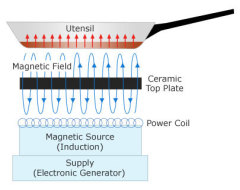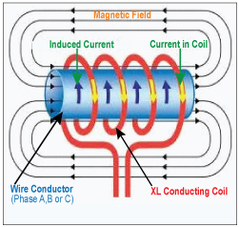XL POWER GENERATION & FARADAY'S LAW
Faraday’s Law of Electro-Magnetic Induction (EMI)
Faraday's law of induction is a basic law of electromagnetism that predicts how a magnetic field will interact with an electric circuit to produce an electromotive force(EMF) which is the phenomenon called Electro-Magnetic Induction (EMI).
EMI is the fundamental operating principle of XL technology as well as transformers, inductors and many types of motors, generators, solenoids and more. It serves as a succinct summary of the ways Voltage (or emf) can be generated by a changing magnetic environment. The induced emf in a coil is equal to the negative of the rate of change of magnetic flux times the number of turns in the coil. It involves the interaction of charge with magnetic field.
The generator action of Electro-Magnetic Induction (EMI) occurring in Multi-Coil XL Chokes generates amperage (Amps) by passing metal wire (XL Conducting Coils) through changing magnetic fields caused by (magnetic flux) caused by magnetized electric amperage running thru copper wire conductors (Phases A,B,C). The generated power consumed by downstream facility loads displaces and therefore reduces upstream billed kW demand and kWh consumption at the utility billing meter. XL Power Generation represents approximately 70% of total XL energy cost savings.
Faraday's Law states that the induced electromotive force (emf) in a closed circuit is equal to the time rate of change of the magnetic flux through the circuit. There are several different ways to generate current (Amps) using Electro-Magnetic Induction (EMI). For example:
- Electric current can be generated only if either the magnetic field is changing (like XL Technology) or the conductor is moving (like the Faraday Flashlight).
- No matter how the change occurs, voltage and current will be generated.
- The change could be produced by:
- changing the magnetic field strength (XL Technology),
- moving a magnet toward or away from the coil,
- moving the coil into or out of the magnetic field (Faraday Flashlight)
- or by rotating the coil relative to the magnet as in the case of generators, motors, etc., which spin a coil of wire (the moving conductor) around a magnet to generate a steady flow of current (Amps).
See this Real Power (Watts) TIS Graph Link to understand how XL Systems generate Real Power (Watts, kW, kWh) to be consumed by downstream electrical loads while displacing and therefore reducing comparable kW Real Power demand and kWh consumption upstream at the utility billing meter.
 Induction cooking works by directing heat to the cooking vessel rather than heating surfaces and the kitchen. Apart from the area under the cooking vessel other areas remain cool.
Induction cooking works by directing heat to the cooking vessel rather than heating surfaces and the kitchen. Apart from the area under the cooking vessel other areas remain cool.
Electromagnetic induction occurs when a circuit with an alternating current AC flowing through it generates current in another circuit simply by being placed nearby.
An alternating current is the kind of electricity flowing through power lines and home wiring, as opposed to a direct current, which we get from batteries.
How does one circuit induce or generate a current in another circuit without touching it, and what does any of this have to do with magnetism?
Before answering this question, consider the some of the otehr basic principles that link Magnetism and Electricity:
- Every electric current has a magnetic field surrounding it.
- Alternating currents have fluctuating magnetic fields.
- Fluctuating magnetic fields cause currents to flow in conductors placed within them, which is also known as Faraday's Law of Electro-Magnetic Induction (EMI).
Adding these three properties together means that a changing electric current is surrounded by an associated changing magnetic field, which in turn generates a changing electrical current in a conductor placed within it, which has its own magnetic field and so on.
Thus, in the case of Electro-Magnetic Induction (EMI), placing a conductor in the magnetic field surrounding the first current generates the second current which is how XL technology works in terms of power generation, XL Power Conditioning happens differently.
Induction is also the principle that makes electric motors, generators and transformers possible, as well as items closer to home such as rechargeable electric toothbrushes and wireless communication devices.

